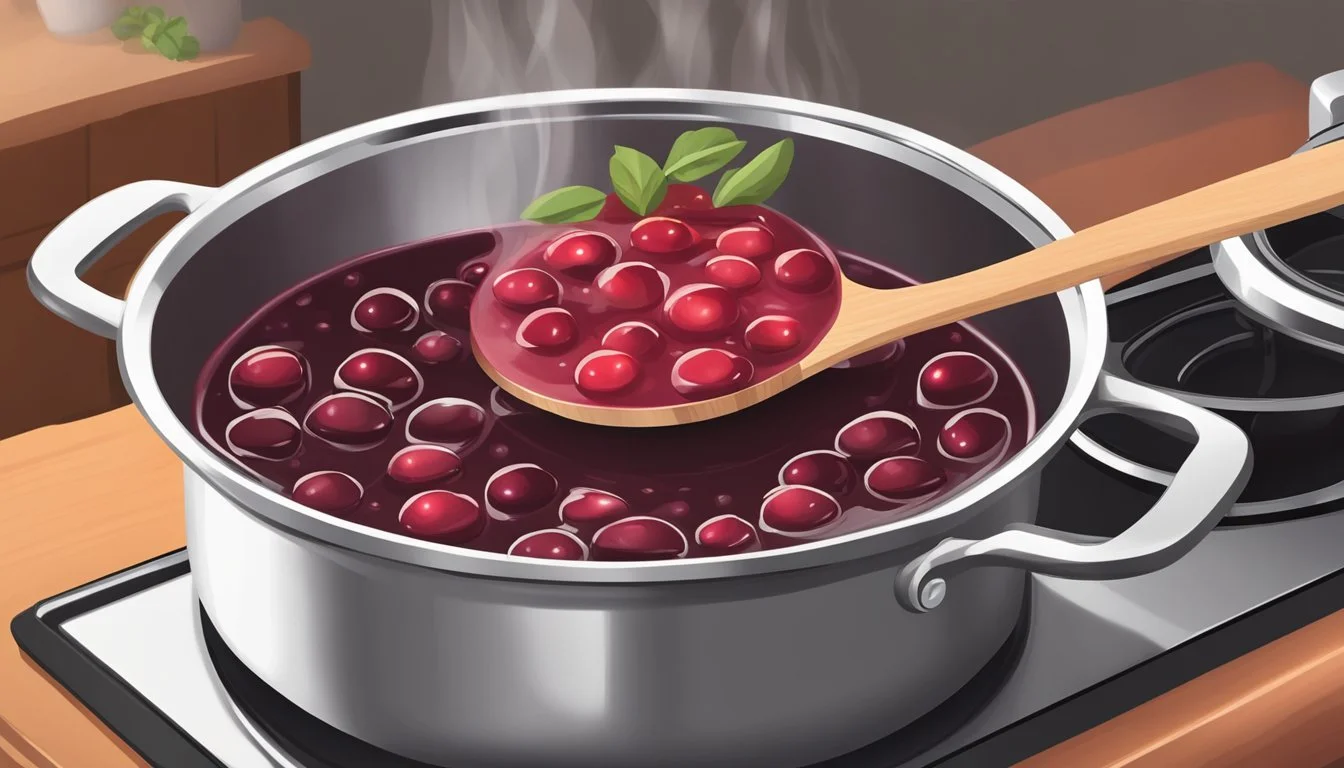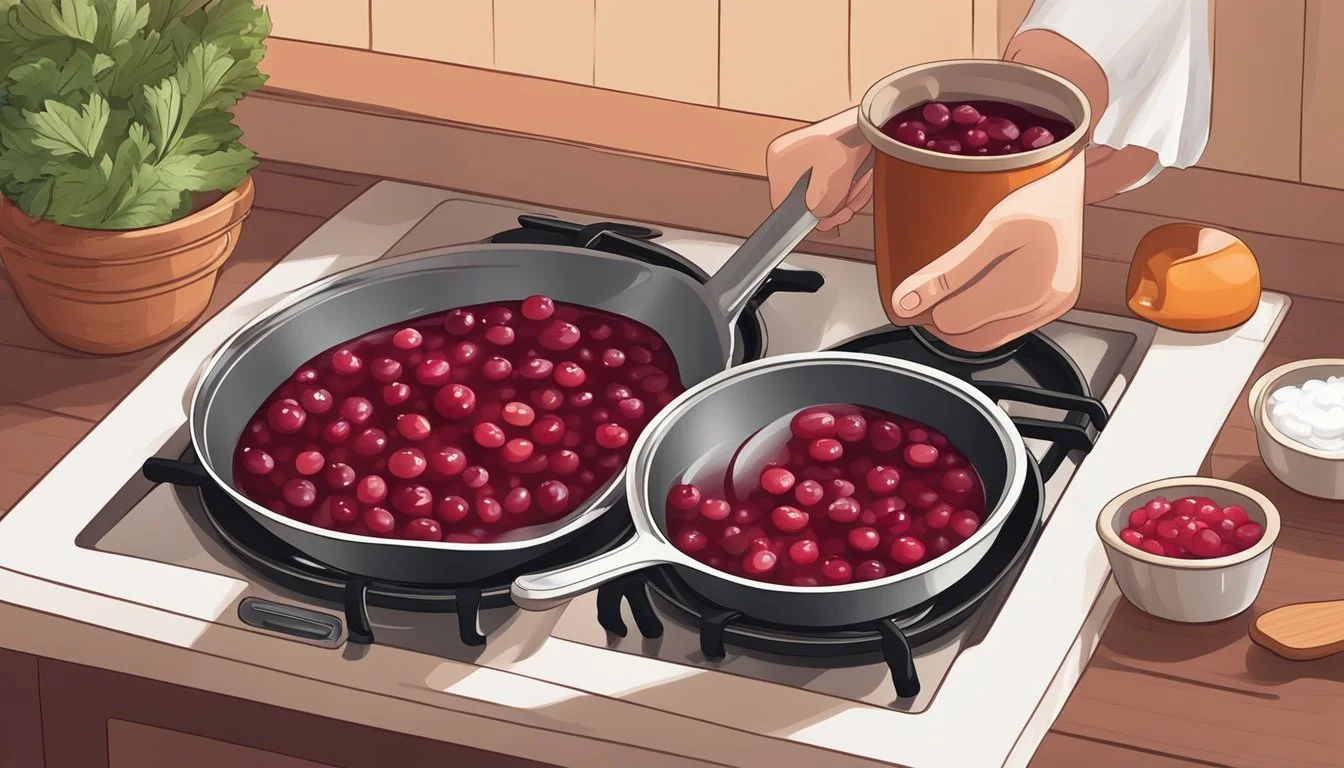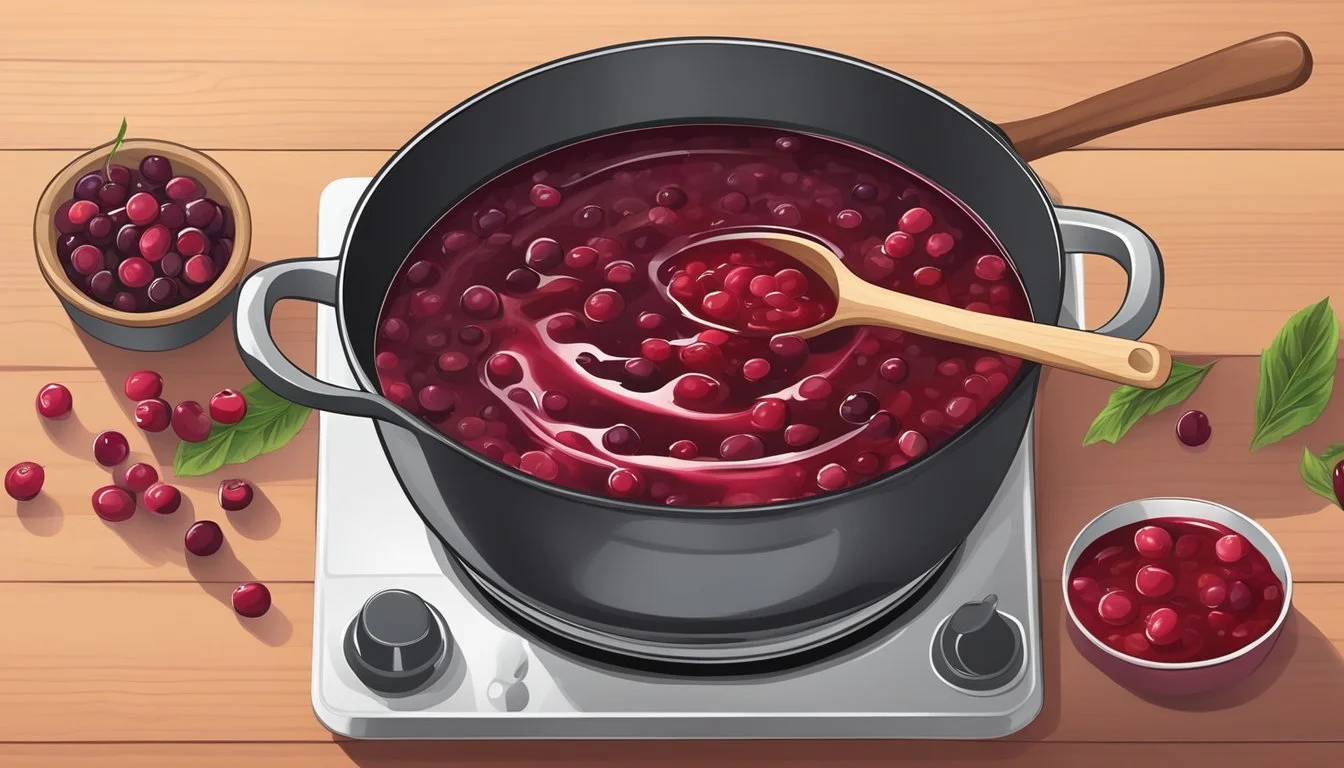Best Way to Reheat Cranberry Sauce
Ensuring Consistent Texture and Taste
Cranberry sauce is a quintessential component of many holiday tables, offering a burst of tangy, sweet flavor that complements a variety of dishes. As Thanksgiving and the holiday season draw near, hosts and home cooks often find themselves questioning the best methods to reheat cranberry sauce while preserving its thickness and distinctive taste. The goal is to serve it warm and delicious, as if it were freshly made.
Reheating cranberry sauce properly is essential, as it can become too runny or lose the nuanced flavors that make it a crowd favorite. The process should gently bring the sauce to the desired temperature without altering its consistency. To achieve this, a controlled approach using either a microwave at a reduced power setting or gentle warming in an oven has proven effective. These methods help retain the sauce's body and enhance its inherent flavors, which are particularly important during a season that celebrates culinary traditions and rich, hearty meals.
Importance of Reheating Method
Reheating cranberry sauce properly is crucial to preserving its texture and flavor. The method used can significantly impact the final outcome, affecting whether the sauce maintains its perfect consistency or becomes too thin or overly thick.
Microwave Method:
Pros: Quick reheating
Cons: Can cause uneven heating
To mitigate this, one should reheat in brief intervals, stirring consistently.
Oven Method:
Pros: More even heating
Cons: Takes longer
Using this method at a temperature of 350°F and stirring occasionally ensures even warmth without reducing the sauce too much.
Each method requires careful attention to detail:
One must avoid overheating, which can break down the pectin—responsible for cranberry sauce's gel-like consistency.
Sauce texture should remain spreadable yet hold its shape on a plate.
Intermittent stirring is vital to distribute heat and prevent scorching, ensuring the sauce remains flavorful and rich in color.
A gentle and controlled approach will result in a cranberry sauce that is both delectable and has retained its perfect consistency, enhancing the overall dining experience.
Understanding Cranberry Sauce
In exploring the best ways to reheat cranberry sauce, it is essential to understand its composition, the different types available, and the sauce's traditional role at mealtime.
Composition and Texture
Cranberry sauce is a condiment typically made by cooking cranberries with sugar and water, leading to the natural release of pectin from the cranberries which thickens the sauce. The sauce can range from a smooth jelly to a coarser jam-like consistency depending on the cooking time and technique.
Types of Cranberry Sauce
There are generally two types of cranberry sauce—homemade and canned.
Homemade cranberry sauce usually has a fresher taste and a more complex texture because it often contains whole berries.
Canned cranberry sauce comes in two forms:
Whole berry sauce, which retains some texture
Jellied sauce, which is smoother and more uniform.
Both homemade and canned versions can be served as leftover cranberry sauce, which might necessitate reheating.
Role in Holiday Meals
Cranberry sauce holds a pivotal place in holiday meals (What wine goes well with holiday meals?), where it complements the flavors of dishes like roasted turkey and stuffing. Its bright flavor cuts through the richness of other holiday foods, balancing the overall palate of the feast.
Preparatory Steps Before Reheating
Before reheating cranberry sauce, ensure that it has been stored and prepared for warming in a way that maintains its thickness and flavor. Proper storage and pre-warming preparation are crucial.
Storing Cranberry Sauce
Cranberry sauce should be kept in an airtight container to prevent moisture loss and absorption of other flavors from the fridge. If it's in the original can, transfer to a container and seal with a lid or plastic wrap. For optimal flavor, cranberry sauce should be consumed within 10-14 days when stored in the fridge.
Thawing If Frozen
If cranberry sauce is frozen, it is best to thaw it in the fridge to prevent a drop in quality. Allow the sauce to reach fridge temperature slowly; this process can take several hours or overnight, depending on the quantity. Thawing at room temperature is not recommended, as it may lead to uneven texture and potential bacterial growth.
Selecting Reheating Containers
When selecting containers for reheating, choose oven-safe or microwave-safe dishes according to the reheating method you plan to use. Glass or ceramic dishes are typically best for oven reheating, while microwave-safe containers are necessary for microwave use. Covering the sauce with a lid or foil can help retain moisture and evenly distribute heat.
Reheating Techniques
Cranberry sauce's consistency and zest can be maintained effectively by using proper reheating techniques. That being said, different methods can be used to reheat cranberry sauce, each having its own merits, ensuring its thickness and flavor is preserved.
Stovetop Reheating
To reheat cranberry sauce on the stove, one should use a saucepan. They should place the saucepan on a burner and set it to a low heat setting, allowing the cranberry sauce to simmer gently. This method provides control over the temperature and prevents burning, which is crucial for maintaining the sauce's texture.
Microwave Reheating
Using a microwave requires heating the cranberry sauce in short intervals, typically around 30 to 60 seconds, and stirring in between to ensure even reheating. The microwave should be set to a medium-low power setting to avoid overheating the sauce, which helps maintain its desired thickness and prevent flavor loss.
Oven Reheating
When reheating cranberry sauce in an oven, it should be preheated to 350°F. The sauce should be transferred into an oven-safe dish and covered with foil to retain moisture. It usually requires around 15-20 minutes for the cranberry sauce to heat through evenly. Stirring occasionally is recommended to maintain an even temperature throughout.
Maintaining Quality During Reheating
Reheating cranberry sauce properly is crucial to preserve its thickness and flavor. A balanced addition of ingredients and careful monitoring of the cooking time can ensure the sauce's quality remains intact.
Adjusting Ingredients and Liquids
When reheating cranberry sauce, one may need to adjust the levels of ingredients and liquids to maintain the original consistency and taste. If the sauce has thickened too much in the refrigerator, it's permissible to thin it by adding a small amount of liquid—such as water, orange juice, or apple cider. One should add the liquid spoonful by spoonful to avoid over-thinning.
Orange juice or apple cider can also enhance the flavor while thinning the sauce.
To sweeten the sauce, brown sugar or a small amount of sugar can be incorporated.
If the sauce is too thin, a thickening agent such as a cornstarch slurry, tapioca starch, or flour can be used. Mix the thickening agent with cold water to create a slurry before adding it to the sauce to prevent clumps.
Example: To thicken one cup of sauce, mix one tablespoon of cornstarch with two tablespoons of water.
Monitoring Cooking Time
Cooking time directly impacts the final thickness and flavor of cranberry sauce. When reheating:
One should heat the sauce slowly and stir frequently to avoid burning and to promote even heat distribution.
Utilize low to medium heat for stovetop reheating, and if using a microwave, reheat in short bursts, stirring between.
Simmering is an effective method to gradually reheat the sauce, enabling one to reduce the liquid if necessary and concentrate the flavors.
For a more flavorful result, spices or citrus zest, such as orange zest, can be added during reheating to intensify the aromatics.
Microwave example: Heat in 30-second intervals, stirring in between, until the desired temperature is reached.
Stovetop example: Heat over low heat, stirring occasionally until the sauce is evenly heated through.
By paying attention to both the adjustment of ingredients and the monitoring of cooking time, one can ensure cranberry sauce retains its desired thickness and flavor during reheating.
Enhancing Flavored Profiles
While reheating your cranberry sauce, consider elevating its flavor profile. A thoughtful addition of spices or sweeteners can revitalize the taste and add complexity. Here are a few suggestions:
Sweet Additions:
Maple Syrup: Introduce a subtle, woody sweetness by adding a tablespoon of maple syrup.
Honey: For a natural and gentle sweetness, a drizzle of honey works beautifully.
Spices and Aromatics:
Cinnamon: A pinch of ground cinnamon imparts a warm and inviting note.
Vanilla Extract: Just a teaspoon can enrich the sauce with a comforting, sweet aroma.
Clove: One or two whole cloves infuse a strong, spicy flavor—remove them after reheating.
Fruit and Zest:
Orange Zest: Grating fresh zest enhances the sauce with a bright, citrusy tang.
Alcohol:
Consider deglazing with a splash of alcohol, such as brandy or orange liqueur, to add depth. Alcohol should be used sparingly to prevent overpowering the cranberry's natural flavor.
When reheating leftovers, these additions should blend seamlessly. Always taste and adjust according to preference, keeping in mind that flavors intensify when heated. Whether enhancing an old recipe or experimenting with remaining sauce, these ingredients can transform the ordinary into a refined complement for any meal.
Accompaniments and Pairings
Properly reheated cranberry sauce can be the crowning touch to many dishes, providing a balance of tartness and sweetness. It excels as both a condiment and a glaze and can elevate the flavors of a variety of accompaniments.
Complementary Dishes
Cranberry sauce is a classic side dish for holiday meals, especially when considering Thanksgiving dinner. It pairs exceptionally well with turkey, where its unique tartness cuts through the richness of the meat. It also complements other meats such as chicken or pork, offering a fruity counterpoint that enhances the overall meal.
Dishes that pair well with cranberry sauce:
Roast turkey: The sauce's acidity balances the savory flavors.
Gravy: A small dollop can add a hint of fruitiness.
Green bean casserole: A spoonful of cranberry sauce can add a refreshing contrast.
Creative Uses for Leftovers
Cranberry sauce can be transformed beyond its role on the holiday table. When it comes to leftovers, it can be repurposed into a glaze for meats or swirled into desserts for a sweet-tart flavor. As a condiment, it adds complexity to sandwiches and can be stirred into dressings or marinades to invigorate post-holiday meals.
Ideas for using leftover cranberry sauce:
Glaze for meats: Apply to chicken or pork before baking to infuse sweetness and tang.
Condiment for sandwiches: Elevates a simple turkey sandwich to a flavorful leftover delight.
Preservation After Reheating
Once the cranberry sauce has been reheated, it is essential to store it correctly to maintain its thickness and flavor. If there is leftover sauce, promptly storing it in the refrigerator or freezer is crucial. Here are the best practices for preserving cranberry sauce:
In the Refrigerator:
Cooling Down: Allow the sauce to reach room temperature before storage.
Airtight Container: Transfer the sauce to an airtight container to prevent it from absorbing odors.
Duration: Refrigerated cranberry sauce stays fresh for 10-14 days.
In the Freezer:
Preparation for Freezing: Place the cooled sauce in a freeze-safe airtight container or a heavy-duty freezer bag.
Headspace: Leave about half an inch of space at the top to allow for expansion.
Labeling: Tag the container with the current date for reference.
Freezing Duration:
Best quality for 1-2 months.
Usable up to 3 months with minimal flavor loss.
When ready to use again, one may choose to thaw the cranberry sauce either in the refrigerator overnight or use the microwave's defrost setting for a quicker option. After thawing, if the consistency has altered, a gentle stir or a brief heat-up may return it to the desired thickness. Using these methods helps ensure that the reheated cranberry sauce retains its quality and taste during subsequent uses.








